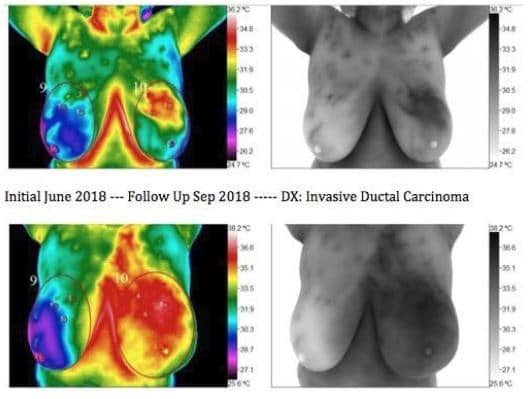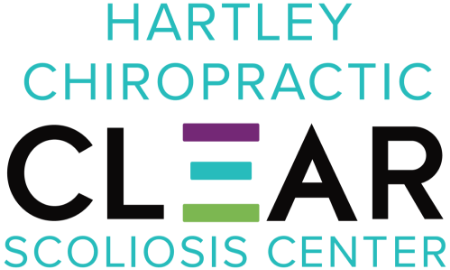 Breast Thermography is a non-invasive and painless way to screen for breast cancer without radiation or compression of the breast. It uses state of the art medical infrared technology to assess heat in the breast. Comparative exams create a baseline for monitoring breast health based on individual thermal patterns and changes.
Breast Thermography is a non-invasive and painless way to screen for breast cancer without radiation or compression of the breast. It uses state of the art medical infrared technology to assess heat in the breast. Comparative exams create a baseline for monitoring breast health based on individual thermal patterns and changes.
Scientists use infrared technology in most aspects of modern science including weather, space programs, military, espionage, and other applications. In these areas thermography is a 100% reliable tool for assessment to be used along with other technologies.
In the realm of breast thermography, the focus is on identifying heat patterns in the breast that could be indicative of pathology. Tumor growth typically results in increased vascular patterns, which can be detected using advanced infrared cameras. Thermography aims to establish a baseline for overall breast health and wellness.
The above image is of a patient with Invasive Ductal Carcinoma that was not found on mammography months prior. This image shows the progression in to the lymph system and adjacent musculature.
How Does Thermography Work?
Modern Thermologists use digital cameras that record infrared radiation emitted by the human body and convert them into temperature readings and plot them on a computer screen. Thermologist’s are then able to identify areas of hot and cold in relation to the opposite side of the body. Areas with decreased blood flow will have colder temperature readings and areas of increased blood flow will have warmer temperature readings.
Breast tumors and some other tumors are able to found on thermal imaging through the process known as Angioneogenesis, the formation of new blood vessel that supply nutrients to a tumor. This asymmetric increase in blood flow creates an increase in temperature that can be picked up by medical thermal cameras. Many times this blood supply increases over time as a tumor grows and is an important part of baseline studies and the ability for them to identify a tumor at the earliest possible moment.
Thermography History
Breast Thermography was introduced in Quebec Canada in 1956 by Dr Robert Lawson who published the first medical paper on breast thermography on 26 women with breast cancer. His research showed that women with breast cancer had over a 2 degrees delta T when comparing the pathological breast with the opposite side. In the 1960’s infrared cameras were introduced and the first Barnes Thermograph was patented. Later liquid crystal bras and plates were used as a more affordable method of screening.
In 1972, the Department of Health, Education and Welfare declared that Breast Thermography was ‘Beyond Experimental.’ Over 4000 articles were published on thermography and over 800 focused on breast thermography. All major medical institutions implemented the technology in the USA. Other countries adopted the use as well.

The above image is that of the first thermal study performed by Robert Lawson in Quebec, CA in 1956. This was published and can be found in PUBMED
Thermography vs Mammography
Thermography is a reliable and comfortable adjunctive procedure that is used in conjunction with traditional screening methods for conditions including breast cancer. Please understand that Thermography is NOT a stand-alone diagnostic test, but it provides valuable additional information that can be used in a holistic screening approach.
Indeed, there have been instances where thermography has helped identify areas of concern in women who have undergone mammography with no detected issues. The November 2012 issue of the New England Journal of Medicine discusses the potential benefits of integrating different methods for a comprehensive screening strategy.
Thermography has additional importance in addressing the often overlooked demographic of women under the age of 40, and those with dense breasts. These groups sometimes present challenges for traditional screening methods. Annually, over 20,000 cases of breast cancer occur in the US in the under 40 age group, and the nature of the disease in these cases tends to be more aggressive, less responsive to treatment. Currently, there’s no routine screening protocol for these women.
In this context, thermography offers potential as a useful adjunctive screening procedure. It does not replace any existing methods, but can be an important tool in the arsenal of preventative healthcare for women of all ages and conditions. This potential of thermography warrants further investigation and research to continue enhancing women’s health practices.
Breast Thermography Exam Process
Thermography is a non-invasive physical test that takes approximately 15 minutes. This process doesn’t exert any pressure on the breast, differentiating it from some other screening tests. It leverages digital infrared imaging to identify any symmetrical variations in the breast. Women with implants or those who have undergone a mastectomy may require specialized evaluation procedures, but can still benefit from this test.
The thermography test is conducted in the healthcare provider’s office. Initially, the patient will be asked to complete a breast history form. The examination takes place in a private setting, often separated by a curtain for patient comfort and privacy. To align the patient’s body with the room’s temperature, a settling period of 10-15 minutes is necessary before imaging.
The patient is then positioned in front of the thermography system to capture images of the upper chest, underarms, and breasts. The infrared imaging camera takes these images and stores them for future comparisons, establishing a baseline over time. This technology can provide clear insights into vascular patterns, temperature variations, and potential physiological conditions.
Once captured, these images are interpreted by a PACT (Professional Academy of Clinical Thermology) Certified Clinical Thermologist. They will process and grade the images digitally, adhering to the standardized reading protocol set by PACT. This methodical process ensures the utmost reliability and consistency in screening
Importance of Breast Thermography Follow-up

The images were taken at 3-month interval. As it is seen here the progression of Breast Cancer can be rapid. Proper follow-up ask directed by the interpreting thermologist can not be over-stressed, as the caveat in thermography is the perceived non-importance, or trying to compare it to mammography.
Overall Breast Health and Thermography
We are at the cutting edge in technology and have seen some remarkable presentations in the physiology of the body. We are pioneering areas that have never been seen before. One of these areas is in the area of toxicity. We have established a relationship between Hormone Toxicity/ Fibrocystic Breasts and small pockets of inflammation that we describe as “leopard spots”.
More properly these areas are sequestered areas of inflammation due to toxins(irritants) in the form of several possibilities. Through massive deduction of hundreds of thousands of cases we theorize these points are aberrant and only found in pathological patients. We have established this through clinical experience and intense study of specific habits of our large patient base. For example, we notice an absence or minimization of these spots in patients who live a toxin free life and adhere to strict diet and lifestyle.
We need a large study of this nature but understanding that studies of this size only are performed for drug companies we will probably never see one. The best we can offer at this point is our experience and observations until we can fund such a study.
Why Opt for Breast Thermography?
Breast Thermography, cleared by the FDA, provides a supportive role in the detection of breast cancer, enhancing your overall health strategy. What makes Breast Thermography an attractive choice?
- It prioritizes your safety: Thermography is a 100% safe method to use.
- Offers a radiation-free approach: No radiation is involved in the process, giving you peace of mind.
- Maintains your comfort: The process is contact-free and compression-free, ensuring a comfortable experience.
- Convenience is key: The procedure is straightforward, making it a convenient addition to your health routine.
- Inclusive of All Women: Thermography is a versatile tool that can be utilized irrespective of breast density or the presence of implants, making it an accessible option for all women.
- Helps establish a personalized health baseline: With thermography, an individualized baseline of your breast health can be established.
- Available to younger women: It serves as an effective supplemental tool for women under 40, who often aren’t included in current breast cancer screening guidelines.
- Based on extensive research: With over 30 years of research and 800 peer-reviewed articles, the technique is backed by extensive scientific evidence.
Factors Affecting the Results of Breast Thermography
Not all tests are perfect or 100 percent accurate. It is important to combine testing for optimal outcome. The following will limit successful outcome measurements to a point”
- Patient’s age
- Ability to stay still in the proper positions
- Excessive use of bras
- Seat warmers, over exercising, caffeine use
- Medications usages including hormone pills and birth control
- Obesity
- Extra large breasts
- Implants
The Promise of Breast Thermography
Thermology has become a valued and recognized tool in the scientific community. It is used in many disciplines of science and is growing as a viable choice for imaging the physiology of the human body. Thermography should be used by medical personnel in the fight against breast cancer and the promotion of breast health.
Breast Thermography Testing and The FDA
The Food and Drug Administration has cleared thermography for several purposes as an adjunctive screening. One of these is breast cancer screening. It is important to understand that breast thermography is not a stand alone procedure for breast cancer screening.
BTI’s Stance
We make it clear in all of our testing that the FDA stance on breast thermography is a valid one and has been adopted by Breast Thermography International and the Professional Academy of Clinical Thermology. The more information in the quest for the early detection of breast cancer that we have the more lives will be saved. The November 2012 article in the New England Journal of Medicine brought this fact to light. Mammograms have failed to reduce fatalities in cancer across a population base as a sole method of screening. We hope the medical community will analyze this data and provide a multi modal approach to breast cancer screening. We would like to see research in the area of combining non radiation tests (MRI, Ultrasound, Thermography). It would be simple to incorporate breast thermography in to the current screening regiments.
None of the case studies within this site should lead any patient to choose breast thermography as the sole method for screening.
What Else Can Thermography Detect?
Breast Thermography is a versatile tool, offering insights into a variety of physiological aspects beyond breast health. It measures skin surface temperature and can play a part in detecting and monitoring:
- Breast Health: By establishing a baseline and identifying any temperature changes over time.
- Breast Cancer: It plays a supporting role in the detection process, used in conjunction with other diagnostic procedures.
- Thyroid Pathology: Thermography may provide supportive information regarding thyroid health.
- Cerebrovascular Health: It can highlight potential issues related to blood flow in the brain.
- Nerve Pathology: Abnormalities related to nerve function might be suggested through thermography.
- Inflammation: By identifying areas of heat, it may indicate sites of inflammation in the body.
- Infection: Temperature patterns may help identify areas of potential infection.
- Fibrocystic Breast Disease: Thermography can monitor changes over time.
- Vascular Disease: It might be beneficial in recognizing signs related to vascular health.
- Lymphatic Stagnation: It may assist in identifying potential lymphatic congestion.
- Alterations in Skin Surface Temperature: Any changes can be monitored and used to inform further investigations.
It’s important to note that while thermography provides valuable adjunctive data, it is not a standalone diagnostic tool for these conditions. Its strength lies in complementing other tests and procedures as part of a holistic health assessment approach. Always consult your healthcare provider for comprehensive examinations and interpretations of your thermography results.
Contemporary Analysis of Breast Thermography, Piana, Sepper
Article published in the Pan American Journal of Medical Thermology (PAJMT)
Background
Breast cancer is one of the major problems of modern oncology, and has certainly received the most attention. The World Health Organization (WHO) estimates that by 2030 there will be 26.4 million new cases of breast cancer annually worldwide, and 17 million people will die from this terrible disease.
Breast cancer is frequently found in women predominantly between the ages of 32-38 years old who are pregnant or have just given birth. According to statistics, breast cancer occurs 1 in 3000 pregnancy cases. About 3% of all cases are diagnosed during pregnancy, and 25% are seen in women less than 45 years of age. It is these women who currently do not have a method of annual screening, and in turn leave behind young families when they die. Adding a valid method of screening for these mothers will allow for a greater survival rate as well as a decrease in overall healthcare expenses. Early detection of breast cancer implies earlier treatment, therefore saving more lives, which the current system of conventional screening mammography has not achieved.
Earlier diagnosis will aid in decreasing the cost of overall healthcare in several areas. First, the number of full radical mastectomies will be reduced and more lumpectomies will be performed. This will cut down on the cost of not only the hospitalization stay, but the time of disability. There would be less reconstructive procedures required as breast integrity can be maintained. Finally, the need for costly chemotherapy could be lessened in the absence of lymph node involvement.
Over the next few weeks we will be educating you about Thermography. Then on December 5th our office will be hosting a Lunch and Learn catered by Diane’s Health Food Cafe with Screenings held at our office December 7th and December 9th.

